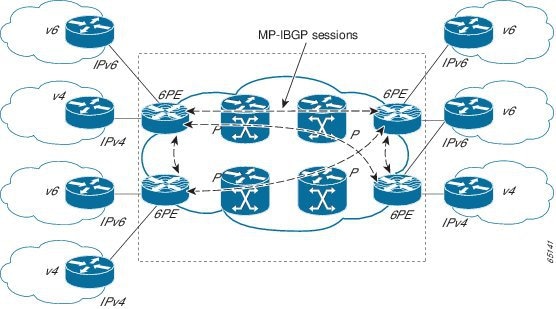In the following
example, output information about an IPv6 route is displayed using the
show bgp ipv6
command with an IPv6 prefix:
Device# show bgp ipv6 2001:DB8:DDDD::/48
BGP routing table entry for 2001:DB8:DDDD::/48, version 15
Paths: (1 available, best #1, table Global-IPv6-Table)
Not advertised to any peer
Local
::FFFF:192.168.99.70 (metric 20) from 192.168.99.70 (192.168.99.70)
Origin IGP, localpref 100, valid, internal, best
In the following
example, output information about a BGP peer including the IPv6 label
capability is displayed using the
show bgp ipv6
neighbors command with an IP address:
Device# show bgp ipv6 neighbors 192.168.99.70
BGP neighbor is 192.168.99.70, remote AS 65000, internal link
BGP version 4, remote router ID 192.168.99.70
BGP state = Established, up for 00:05:17
Last read 00:00:09, hold time is 0, keepalive interval is 60 seconds
Neighbor capabilities:
Route refresh: advertised and received
Address family IPv6 Unicast: advertised and received
ipv6 MPLS Label capability: advertised and received
Received 54 messages, 0 notifications, 0 in queue
Sent 55 messages, 1 notifications, 0 in queue
Default minimum time between advertisement runs is 5 seconds
For address family: IPv6 Unicast
BGP table version 21880, neighbor version 21880
Index 1, Offset 0, Mask 0x2
Route refresh request: received 0, sent 0
77 accepted prefixes consume 4928 bytes
Prefix advertised 4303, suppressed 0, withdrawn 1328
Number of NLRIs in the update sent: max 1, min 0
In the following
example, output information linking the MPLS label with prefixes is displayed
using the
show mpls
forwarding-table command. If the 6PE feature is configured, the
labels are aggregated because there are several prefixes for one local label,
and the prefix column contains IPv6 instead of a target prefix.
Device# show mpls forwarding-table
Local Outgoing Prefix Bytes Label Outgoing Next Hop
Label Label or Tunnel Id Switched interface
16 Pop Label 10.1.1.1/32 0 Et0/0 10.0.0.1
18 No Label nh-id(1) 0 Et2/0 10.0.2.2
19 No Label nh-id(2) 0 Et1/0 10.0.1.2
20 No Label nh-id(3) 0 Et1/0 10.0.1.2
22 No Label nh-id(5) 0 Et1/0 10.0.1.2
24 No Label nh-id(5) 0 Et2/0 10.0.2.2
In the following
example, output information about the top of the stack label with label
switching information is displayed using the
show bgp ipv6
command with the
labels keyword:
Device# show bgp ipv6 labels
Network Next Hop In tag/Out tag
2001:DB8:DDDD::/64 ::FFFF:192.168.99.70 notag/20
In the following
example, output information about labels from the Cisco Express Forwarding
table is displayed using the
show ipv6 cef
command with an IPv6 prefix:
Device# show ipv6 cef 2001:DB8:DDDD::/64
2001:DB8:DDDD::/64
nexthop ::FFFF:192.168.99.70
fast tag rewrite with Se0/0, point2point, tags imposed {19 20}
In the following
example, output information from the IPv6 routing table is displayed using the
show ipv6 route
command. The output shows the IPv6 MPLS virtual interface as the output
interface of IPv6 routes forwarded across the MPLS cloud. This example shows
output from the 6PE1 router.
The 6PE2 router has
advertised the IPv6 prefix of 2001:DB8:dddd::/48 configured for the CE2 router
and the next-hop address is the IPv4-compatible IPv6 address
::ffff:192.168.99.70, where 192.168.99.70 is the IPv4 address of the 6PE2
router.
Device# show ipv6 route
IPv6 Routing Table - 10 entries
Codes: C - Connected, L - Local, S - Static, R - RIP, B - BGP
I1 - ISIS L1, I2 - ISIS L2, IA - ISIS interarea
B 2001:DB8:DDDD::/64 [200/0]
via ::FFFF:192.168.99.70, IPv6-mpls
B 2001:DB8:DDDD::/64 [200/0]
via ::FFFF:192.168.99.70, IPv6-mpls
L 2001:DB8:FFFF::1/128 [0/0]
via ::, GigabitEthernet0/0/0
C 2001:DB8:FFFF::/64 [0/0]
via ::, GigabitEthernet0/0/0
S 2001:DB8:FFFF::/48 [1/0]
via 2001:DB8:B00:FFFF::2, GigabitEthernet0/0/0



 Feedback
Feedback